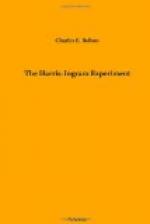“Well, May,” said George, as he kissed her, “can you get ready by noon tomorrow?”
“Ready by noon? Ready by daylight, George, if necessary.”
That night was a busy, happy time for the Ingrams. So much of ill-luck had come to the father, and so much of household drudging to the faithful mother, that work and sacrifice for the children had ploughed deep furrows across the faces of both Mr. and Mrs. Ingram. Opportunities for advancement now opening for their children, both parents found the heavy burdens growing lighter.
Before sunrise George and May had packed two small trunks, by ten o’clock Gertrude and May had made necessary purchases, and the two o’clock express quickly bore the second contingent of the Harris family towards New York, which was reached the night before their steamer’s date of sailing.
For some reason, perhaps because the elements of superstition still lurked in the mind of Colonel Harris, he decided not to stop any more at the Hotel Waldorf. It had brought him ill-luck, so his party was driven to the tall Hotel Plazza which overlooks the Central Park.
Fortunately George had inherited a talent for untiring investigation and the power of close observation. His reasoning faculties also were excellent. Besides his education, gained in a practical school at Troy, George, with, his father, James Ingram, had made many experiments, mostly after business hours; each experiment was numbered and the various results had been carefully noted. Before leaving Harrisville his investigations were all drifting towards great possible changes in the production of iron and steel. He was glad to take this trip to Europe, as it might afford him opportunity to verify or change some of his conclusions. He resolved to use every moment for the enlargement of his powers.
After bidding May and Gertrude good-night, he told the colonel that he should now take the Elevated Railway for the steamer “Campania,” as he wished to observe at midnight the firing of the great battery of boilers of the steamer; and that he would return in time for breakfast with the party. “Let eight o’clock then be the hour, George,” and the capitalist and his trusted superintendent separated for the night.
The elevated railway was not swift enough to carry George Ingram to Pier No. 40, so anxious was he to see the midnight fires started in the hundred furnaces of one of the two largest steamers afloat. It was fifteen minutes to twelve o’clock when he reached the dock, and provided with a letter of introduction to the chief engineer, he hurried as fast as possible to the officer’s cabin.
The young engineer’s night ashore had been spent at the opera, and, advised of George Ingram’s visit, he had promptly returned to the steamer. Mr. Carl Siemens, engineer, was a relative of Siemens Brothers & Co., Limited, the great electrical and telegraph engineers of London. His education had been thorough, and he was very proud of his steamer the “Campania,” especially of the motive power, which he helped to design. He gave young Ingram a cordial greeting.




